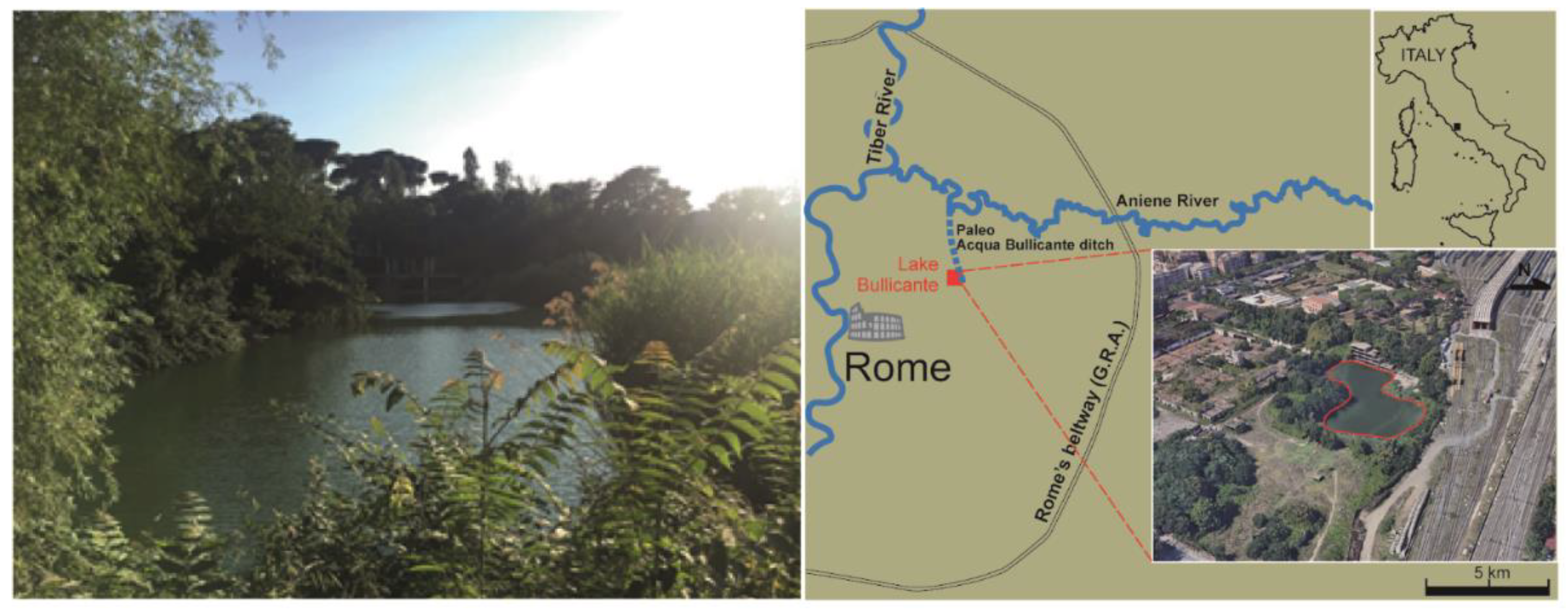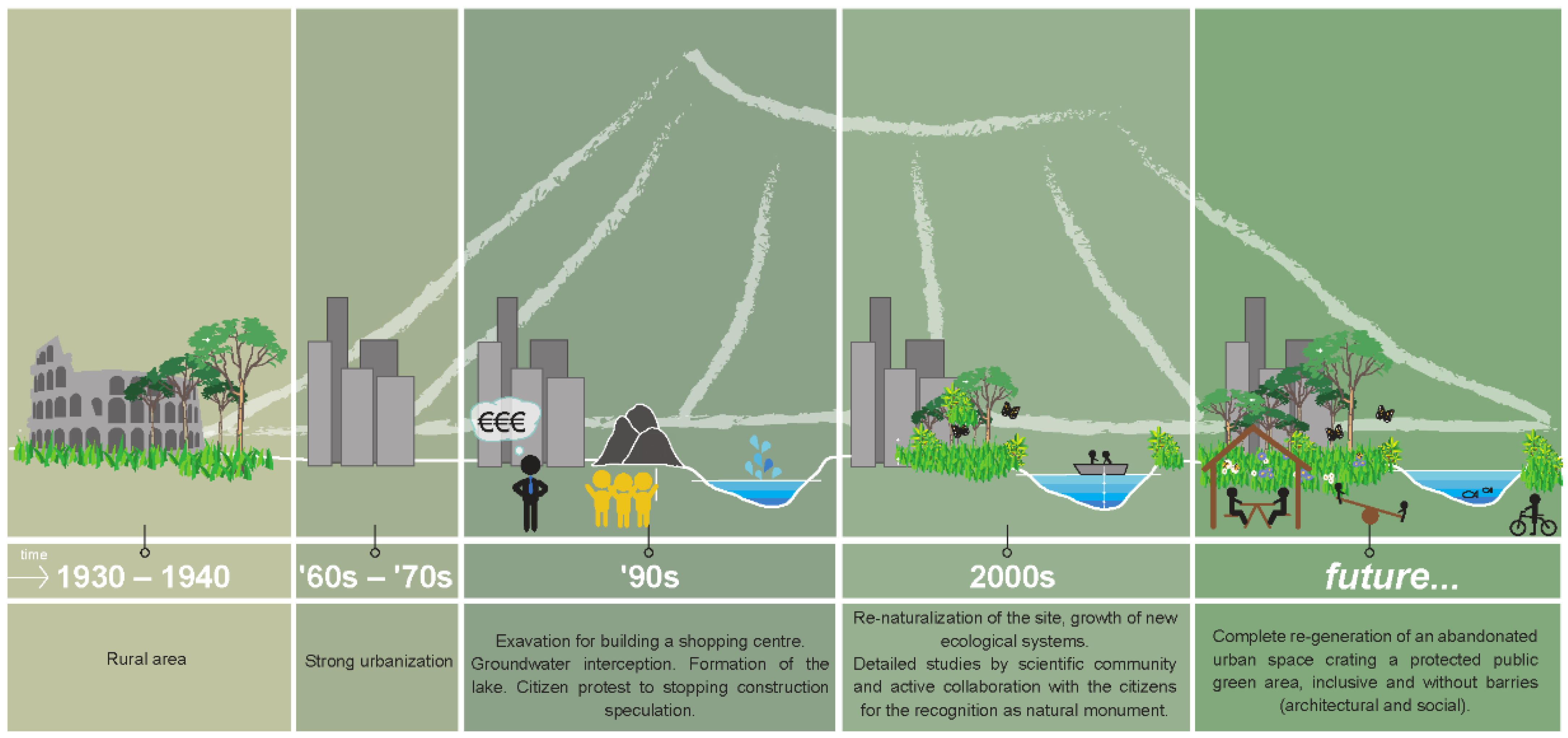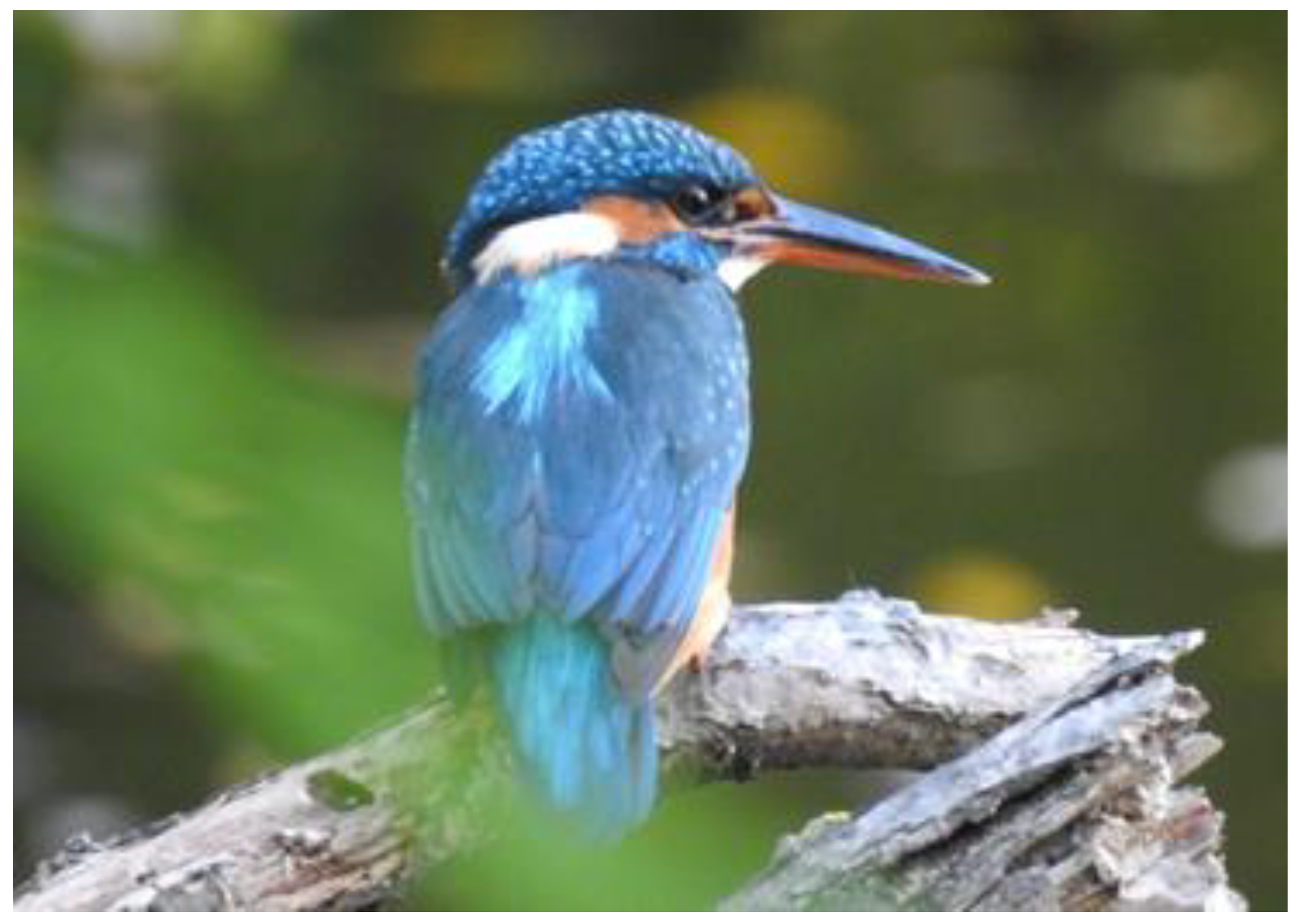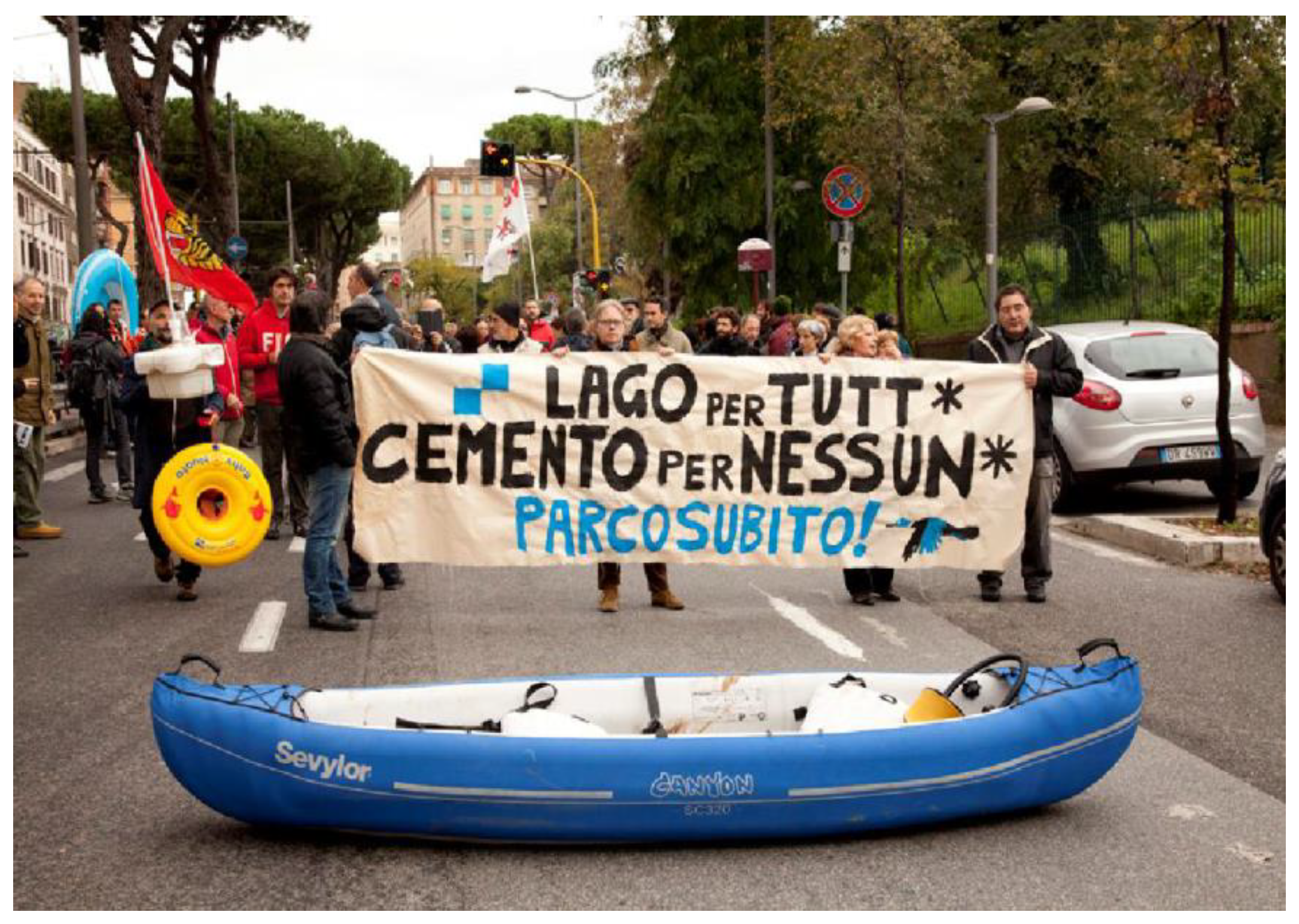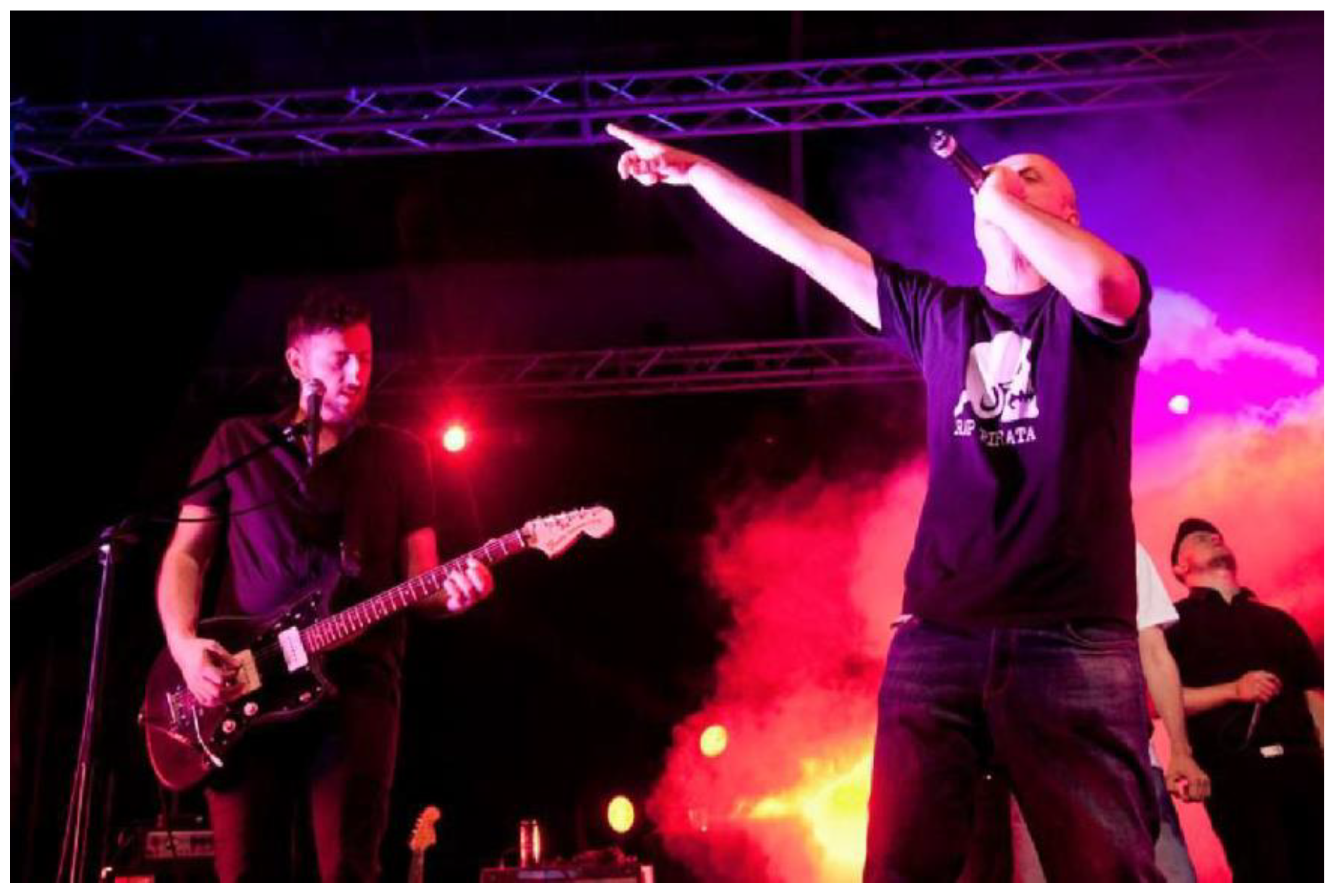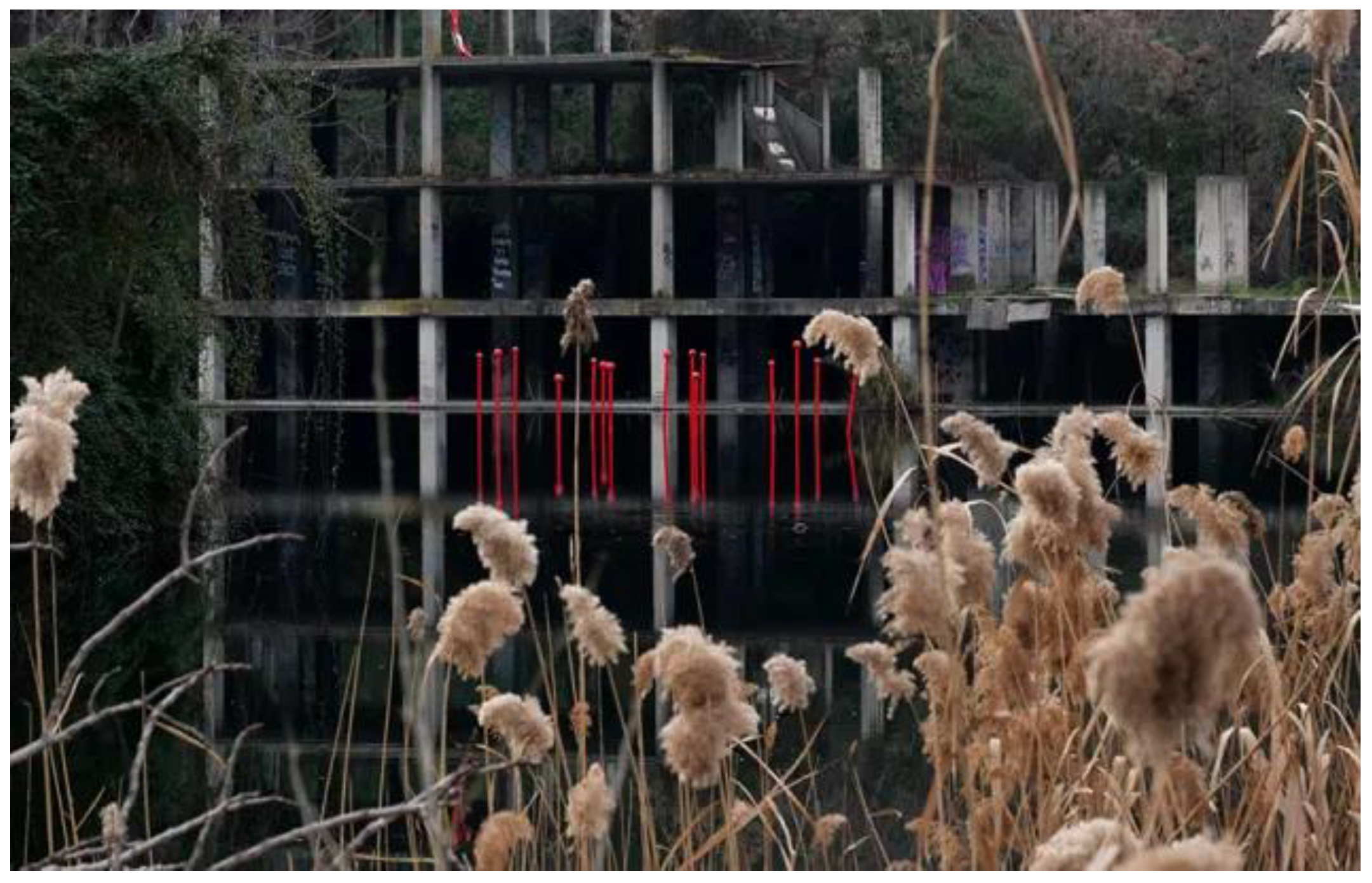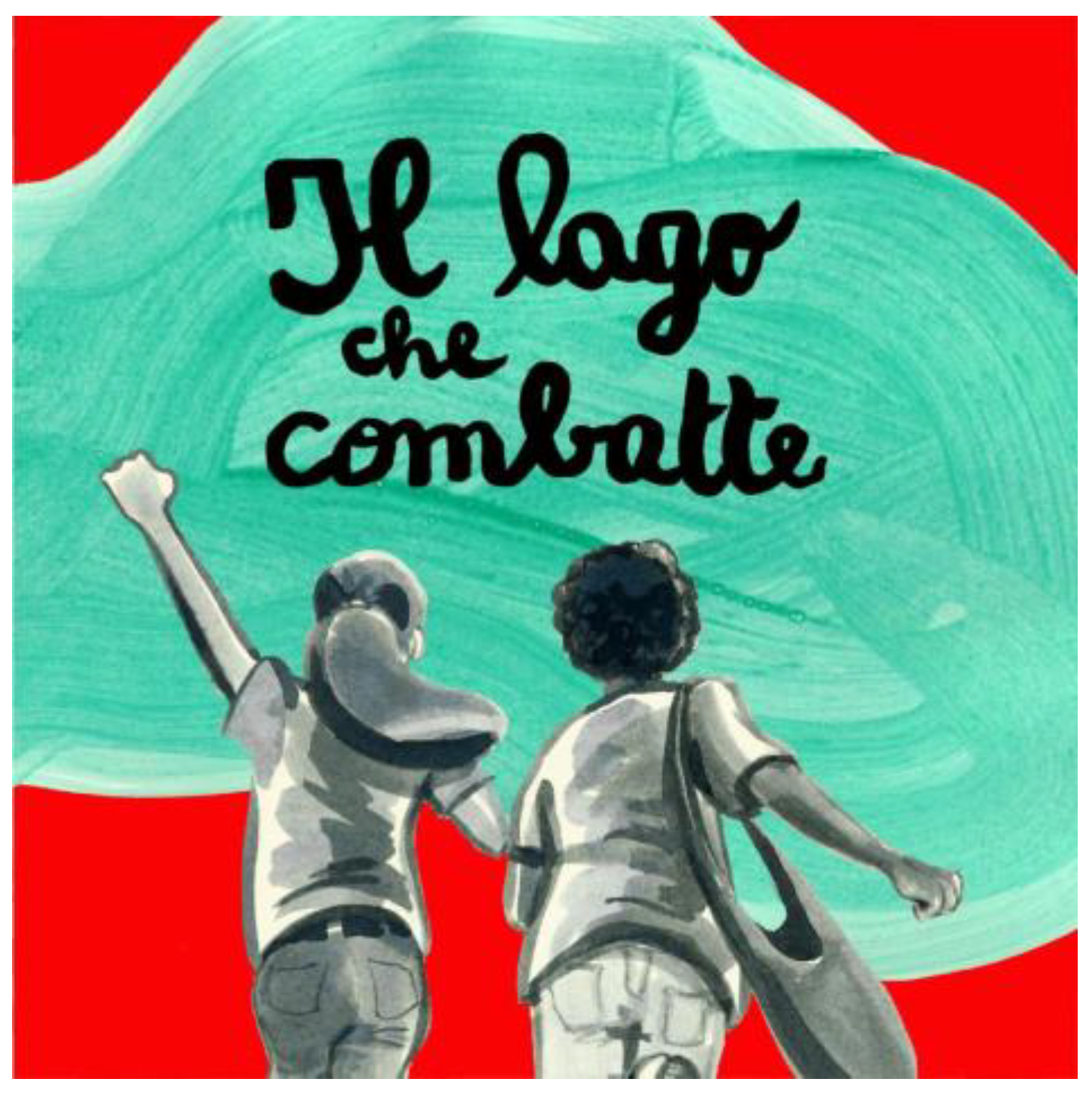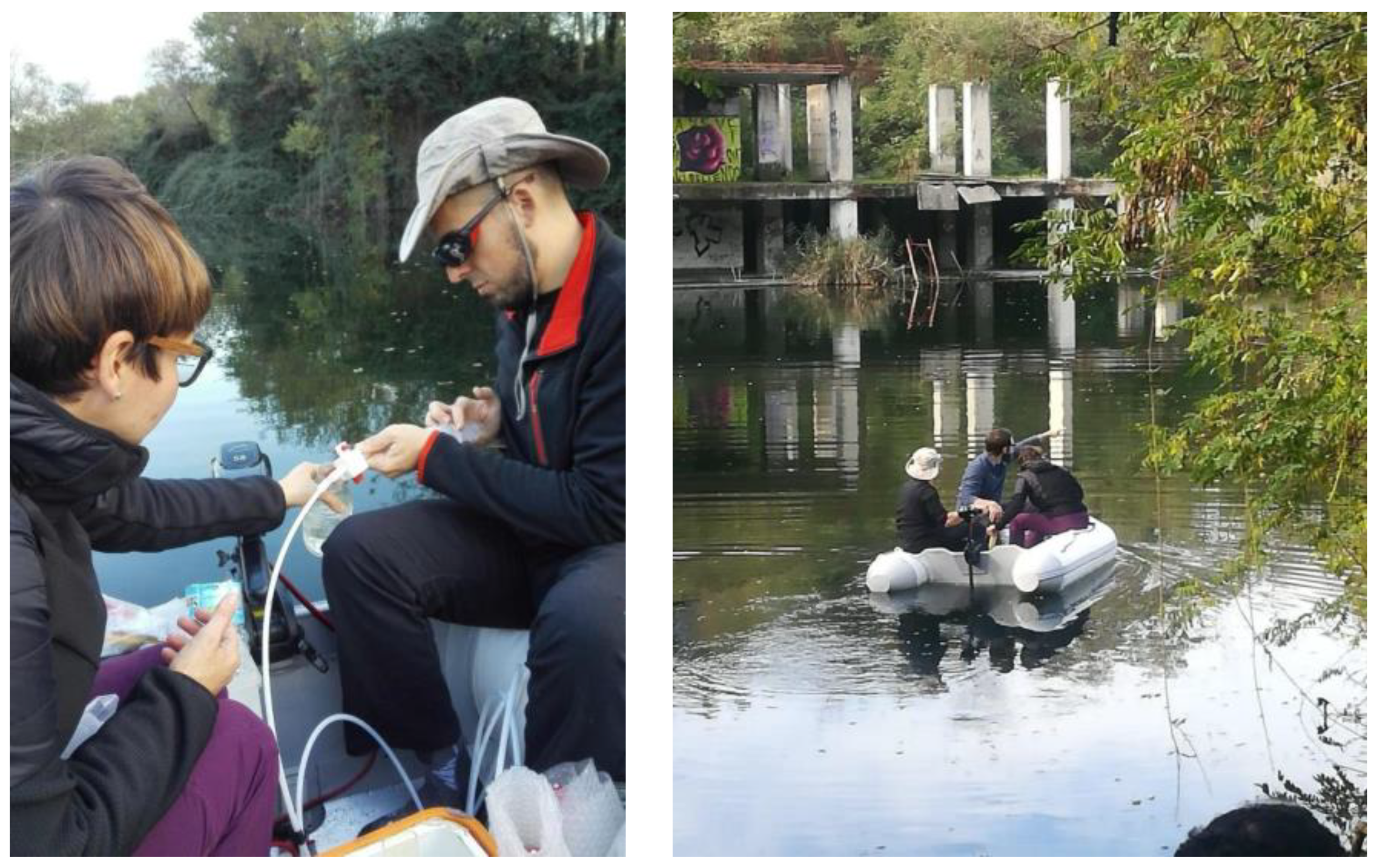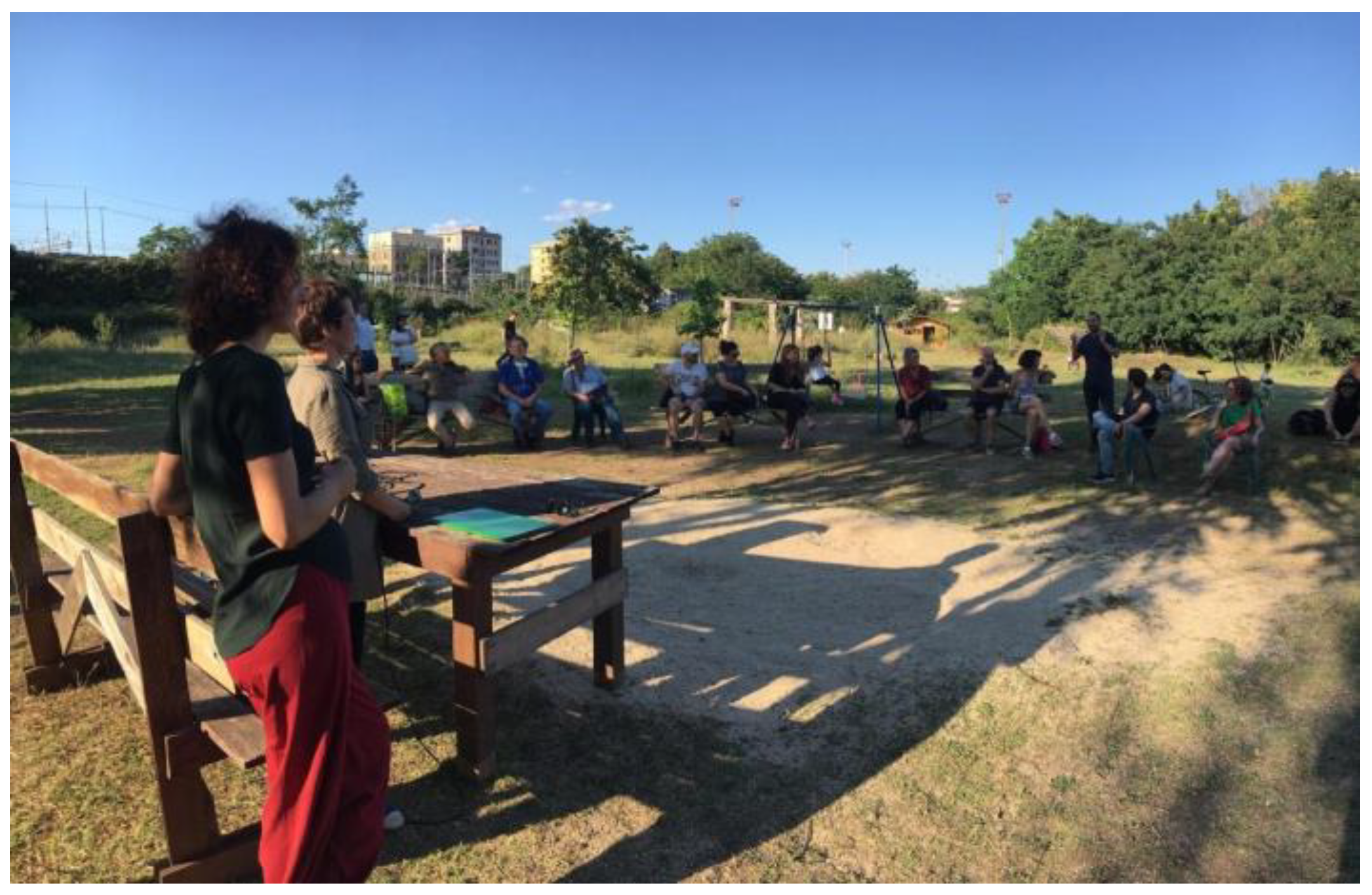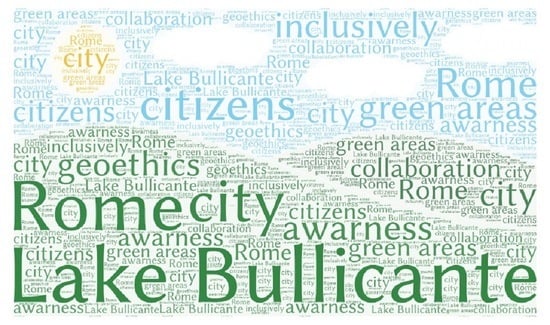1. Introduction
Over half of the worldwide population lives in urban settings [
1]. Thus, cities represent a crucial challenge for human health and future human development, and adequate policies are required to achieve the eleventh Sustainable Development Goal of the United Nations (sustainable cities and communities (
https://sdgs.un.org/goals (accessed 31 March 2022))). Therefore, urban areas are not only places where human people reside and work: cities are also a multifaceted space made of history, culture, social relations and community processes. Green spaces are necessary to conserve part of territorial surface geodiversity, relieve mental stress and improve well-being of citizens [
2]. In this framework, public green spaces for people to get together, providing services to psychophysical health, recreation and societal interactions, have a key role in making cities more livable. As cities and populations continue to rapidly grow and transform, there is a real need to rethink how civic areas are used.
Therefore, cities should be better known, lived and protected in their entirety, considering them also as resources for geo-environmental heritage. In this framework, the cooperation between citizens, local authorities and decision makers and the scientific community appears to be a win-win solution to align different values, needs and expectations on how to live on the territory.
Urban green spaces can provide a multitude of benefits: protecting biodiversity by hosting various types of fauna, such as birds and bees; conserving infiltrating areas to recharge shallow aquifers; source areas of cleaner air; mitigating local urban microclimate [
3] by reducing the impact of heat waves; and assuring ecosystem services related to recreational, emotional and spiritual dimensions of human beings. One of the main tasks of the city municipality is to provide quality public spaces for citizens and a sufficient number of green areas and to ensure their long-term sustainability through effective conservation and management. Moreover, an inclusive public space must guarantee full safety and accessibility to all user groups.
For the above reasons and considering that the urban spaces and, at the same time, urbanization are both geo-ecological and social phenomena [
4], the cooperation between scientists, decision makers and citizens is crucial. Scientists are able to assess and constantly monitor the characteristics and quality of the local environment. Their commitment can also include the dissemination of scientific knowledge about that urban area to local communities and authorities. In this framework, Nilon et al. [
5] affirmed that people need to understand how cities work as ecological systems to take control of the vital links between human actions and environmental quality.
Decision makers and local authorities are required to take all necessary actions to ensure adequate levels of safety for those who use public spaces, through the application of appropriate regulations, and to provide efficient maintenance services and surveillance systems.
Finally, citizens, as end users, have to push local authorities to guarantee safety and full usability of those spaces, and they have the opportunity to increase their awareness about the value of the territory as a public resource that must be used respectfully. Citizens are called to actively contribute to the conservation and protection of those public spaces, being informed about their geo-ecological characteristics from a scientific perspective. This proactive approach has the potential to increase the convincement of the importance of investing public funds into this public resource for the service of citizens and the quality of the urban environment.
In this regard, the results shown in the recent paper of Bixler et al. [
6] are interesting: it was reported that co-producing assessments and solutions formulated by transdisciplinary teams (i.e., combination of different scientific disciplines and community members) can likely generate legitimate and socially acceptable plans that can advance urban sustainability.
In this work, we describe the case study of Bullicante Lake, located in a luxuriant green area in one of the most urbanised sectors in Rome. It can be a good example of how cooperation between all community stakeholders can get positive results in terms of scientific knowledge, sustainability, societal inclusiveness and participation of citizens in public affairs. These are all important reference values for a geoethical approach to land management [
5,
7,
8].
In the past, Lake Bullicante was often threatened by property speculation due to its strategic position and features within the urban area. Joint actions by citizens, the scientific community, artists and institutions were able to redress opportunistic behaviours well, preventing the degradation and the improper use of the green area surrounding the lake, favouring environmental safeguarding and public accessibility. The inclusivity of all citizens in the decision-making process about the future development of this area was successful.
The results achieved in the protection, conservation and enhancement of this natural area make this case a good example of application of an ecological and humanistic perspective in urban land management and close cooperation between social and scientific communities. Furthermore, the practical application of the fundamental reference values proposed by geoethics, such as inclusiveness, sharing, sustainability and conservation of bio- and geodiversity, to the local socio-economic context has proven to be useful to favour a more responsible human approach towards nature and improve the quality of life of citizens. The environmental restoration of the area of Bullicante Lake has generated impacts on aesthetic and recreational aspects of the site, able to satisfy the emotional and spiritual dimensions of the inhabitants of the area by pushing the population to implement innovative solutions to face any problems in the management of this urban space.
2. Applying Geoethical Values
Geoethical thinking is based on the awareness that, in a more or less conscious manner, humankind is strongly modifying social-ecological systems that consist of strictly interconnected biotic, abiotic, social and cultural elements [
9]. Changing physical and biological characteristics of a territory produces modifications also in its social and cultural features, developing a feedback mechanism that drives further local and global anthropogenic changes. In fact, actions by human beings produce profound alterations in the natural environment, which in turn influence economic development and societal perspectives of people on a local and global scale [
10].
Geoethics is defined as “the research and reflection on the values which underpin appropriate behaviours and practices, wherever human activities interact with the Earth system” [
10,
11]. This definition highlights the need to identify values on which to base a more responsible, sustainable and respectful interaction between humans and the Earth system [
3].
From a geoethical perspective, geoscientists produce knowledge and support the decision-making process by suggesting the pros and cons of interventions affecting the natural environment with the goal to find solutions for the public welfare. It is their responsibility to serve society by implementing its sustainable development and assure people’s safety [
12]. For these reasons, they are asked to assume the responsibility of using their knowledge for the benefit of society, promote geoscience literacy [
13] and suggest functional attitudes and proactive behaviours to society in order to foster well-informed economic, technological and social development. This commitment derives from geoscientists′ awareness of being also social actors and having social responsibilities towards human communities. In addition, geoscientists have the knowledge, expertise and professional and cultural sensibility that are essential to protect natural environments, manage natural resources in a prudent way and support sustainable supply chains in order to minimize negative impacts on ecosystems, enhance the scientific, educational, cultural and aesthetic value of bio- and geodiversity and entrust these to future generations [
10].
Geoethics clearly underlines the strong link between ethics, geosciences and human activities and proposes the concepts of geoheritage, geoconservation and geodiversity as social values to promote among citizens [
7,
10]. In line with the geoethics view, restoring a degraded urban area is a geoethical action that has the goal to link human needs to respect for ecosystems. This action gives dignity both to people living in a degraded area and the environment, despite that restoration is a human action that necessary has an impact on nature, although with the goal to recover the quality of geo-ecosystems and to protect their diversity.
In the past years, concepts such as geoheritage, geoconservation and geodiversity have been increasingly framed and developed in order to meet the need to establish a dialogue between geoscientists and decision/policy makers. Geodiversity is defined as “the variety of rocks, minerals, fossils, landforms, sediments, water and soils, together with the natural processes which form and alter them” [
14]. Geoheritage comprises those “elements of the Earth’s geodiversity that are considered to have significant scientific, educational, cultural, aesthetic, ecological or ecosystem service values” [
15]. Geoconservation comprises actions taken to preserve geodiversity and geoheritage in order to ensure that the “face” of the planet (rocks, landscapes, waters) is adequately protected from human interventions for future generations [
11,
14]. “Geoheritage, geodiversity, and geoconservation identify respectively the subject of interest for our actions affecting the abiotic elements of natural environment, its intrinsic and peculiar characteristics, and actions that can protect its existence, although in a context of natural transitoriness” [
16] (p. 19).
These three concepts represent an important resource on which to base: (a) the human sense of places, such as people’s emotional and cultural intimate connections with landscapes, which strengthen the sense of belonging of each person to the land they inhabit; (b) a richer understanding of the identity of human communities; and (c) the stewardship of social-ecological systems. Geoheritage, geodiversity and geoconservation are practical expressions of the geoethical thinking related to the natural environment: recognizing their importance as a means to restoring an inner connection between humans and the geo-ecosystems is a fundamental step to develop sustainable and respectful practices in managing the environment. At the same time, geoethics highlights their intrinsic social and economic value, since geoheritage and geodiversity are part of a non-renewable societal and natural capital.
3. The Importance of a Geoethical Perspective and Geo-Environmental Education in Land Management
Geoethics instils respect for geoheritage and geo- and biodiversity, as well as highlights the importance of preserving the natural and cultural value of natural places as a fundamental element of the identity of local human communities, indispensable witness of the continuous interaction of human beings with the land in which they live. By creating awareness of the value of a place’s geoheritage, “geological culture and geoethics can strengthen the links between people and their land, between the places of their origins and their own memories” [
17].
Those places are real or potential sources of tangible or intangible human community’s cultural, social and economic resources [
10,
18].
Initiatives such as redevelopment of degraded urban areas and their restitution to the public enjoyment are the material expression of those values, a means of restoring the sense of belonging to the social-ecological context and to the geological landscape, resulting in a broader understanding of the value of the natural environment through appreciation and learning [
19].
If properly managed, public spaces, especially in urban areas, such as Bullicante Lake in Rome, can provide opportunities for increasing urban sustainable development, in which geosciences and social sciences interact on common ground. In particular, it can offer many benefits, such as the creation of an effective multidisciplinary laboratory and an educational path for increasing citizens’ awareness of the importance and diversity of natural components and for improving the quality of life for local populations in recreational and economic terms.
In Italy, most times, citizens are considered passive actors in the decision-making chains related to land management, and this often causes situations of strong opponents to decisions that are seen as undue impositions by authorities. Instead, citizens can play a key role because their active involvement in the decision-making process pushes them towards more responsible and cooperative approaches since they feel like owners and not simply guests of the lands in which they live [
16]. From a geoethical perspective, citizens must be empowered to contribute constructively to land management, with the legal and economic support of authorities and suggestions by the scientific community to respect natural processes. Geo-environmental education implies the transfer of knowledge about forms, processes and products of natural or human-induced dynamics, past and present, but it is also a tool for co-creating knowledge and experience [
20], as well as stimulating critical thinking, with positive repercussions in terms of active involvement of citizens in the public discussion about conservation and protection of natural environments and reduction of human activity impact on the geo-ecosystem. Education can shorten the distance between scientists, laypeople and decision makers, increasing public trust in science and local authorities and fostering the development of a “knowledge-based society” [
11,
21].
The possible transformation of the Bullicante Lake area into an open-air scientific and ecological laboratory addressed to the general public can be useful for improving the knowledge and importance of bio- and geodiversity, for learning the historical development and past use of that site and for recognizing the potentiality of it as public good, in respect of its vocational characteristics due to its physical, chemical and biological features.
In fact, this area is of great interest to the population, with several potential activities and structures to be implemented, such as an educational centre where geoscientists and citizens may fruitfully interact, with the creation of educational paths and information panels to explain the co-existence and integration of elements of urban and historical archaeology, peculiar social contexts and ecosystems, associated with recreational services and sport utilities. Positive repercussions in economic and employment terms would be boosted by tourist-recreational activities. At the same time, the protection of biotic communities, the conservation of abiotic resources and the integrity of the site as a whole, as a natural laboratory for both multidisciplinary scientific research and educational activities, would be promoted.
4. Synergetic Activism among Citizens, Science and Arts: The Case of Bullicante Lake
Bullicante Lake (
Figure 1) is a typical example of an urban lake. It is located in a luxuriant green area close to the historical centre of Rome, in the eastern part of the city (on the left bank of the Tiber River), with a high residential rate (9104 inhabitants/km
2) and a very low rate of green area per person (<4 m
2/inhabitant).
Bullicante Lake is locally known also as “Ex SNIA” Lake, from the nearby abandoned textile factory SNIA Viscosa, which was active from 1923 to 1954. The rapid and uncontrolled city growth in the post-World War II period and the presence of an important industrial plant determined the strong urbanization of the area, which in a few years saw a great increase in its population [
22,
23]. When the factory was closed, the area was abandoned for many years. In 1968, a part of the site was subjected to restriction to protect endangered landscape features and to establish a public garden, while the remaining area, including the old industrial buildings and the surrounding areas, was purchased in 1990 by a builder. The lake appeared in 1992 following illegal excavation works, which intercepted the underlying aquifer, hosting in the Alban Hills volcanic deposits [
24], causing the rise of water and the formation of Bullicante Lake (
Figure 2). Due to this event and following citizen protests, illegal works were suspended and the whole area expropriated, preventing additional anthropogenic transformations. The site remained closed and neglected until 2016, favouring re-naturalization processes and the development of new ecological systems [
25].
As previously mentioned, Bullicante Lake is an urban lake. Urban lakes are generally human-made ecosystems resulting from excavation activities (for example, mining activities), with a surface area of a few hectares and an average depth of 3–5 m or less [
26]. They are particularly sensitive to water pollution and eutrophication processes [
27,
28] that, if not controlled and monitored, can lead to the death of the lacustrine living organisms.
Bullicante Lake has an elliptical shape (130 m × 80 m, at the largest point), a surface of about 7000 m
2 and a maximum depth of 7 m. From a geological point of view, it is located in proximity to the
Acqua bullicante paleo-ditch and hosted on the deposits of the first phase of the Alban Hills Volcanic District activity (AHVD), which began about 600,000 years ago and continued up to 350,000 years ago [
24].
The whole stratigraphic sequence hosting the lake is displaced by a fault [
29] in correspondence with which important degassing phenomena were observed in the past [
30]. The lake is fed by a shallow aquifer hosted in the AHVD deposits, characterized by a piezometric level between 18–22 m asl and bounded, at the base, by very low permeability volcanic deposits, more claying and as consequence acting as aquiclude [
31].
The lake and the surrounding areas have a high natural and environmental value characterized by an elevated potential of spontaneous re-naturalization. In fact, naturalists and ecologists are surprised by the extraordinary degree of naturalness that characterizes the lake and its banks, especially considering the limited surface area and the high degree of urbanization. About 300 botanical species, 11 plant communities and 3 priority habitats for the European Union are hosted in the lake and in the surrounding areas. Moreover, 89 species of birds have been recognized, including the
Alcedo atthis (
Figure 3),
Peregrine falcon and the
Dendrocopos major, and several plants such as the
Phragmites australis (marsh reed),
Salix alba (white willow),
Populus alba (white poplar),
Populus nigra (black poplar),
Pinus halepensis (pine of Aleppo) and
Laurus nobilis (bay tree). In the areas bordering the lake, bats, invertebrates such as beetles, lepidoptera and odonates, and vertebrates such as foxes are also recognized [
31].
In light of this, at present, the lake represents a key ecosystemic structure since it can help to connect areas of diverse habitats, allowing species to move between them thanks to migratory stop-overs, stepping stones and “wildlife corridors”.
Unfortunately, the lake has been often threatened by speculation actions due to its strategic position and features within the urban area. In 2008, citizens created a “Permanent Forum” aimed at protecting the lake and surrounding park from further building or economic speculations, and this proved to be a key action joined to the intuition to involve institutions, artists and the scientific community in the environmental safeguard and enhancement movement (
Figure 4).
Several artists, following an invitation by the Permanent Forum, communicated through their works the history and the worth of the lake and surrounding place. In 2014, two Italian music bands, “Assalti Frontali” and “Muro del Canto”, dedicated a song to the lake, entitled “
Il lago che combatte” (The lake that fights), telling the formation of the lake and its environmental value and personifying it while it was opposing to threats and speculations (
https://www.youtube.com/watch?v=Dcb_Thrq2P8; this video received more than 1.3 million views (accessed on 31 March 2022)) (
Figure 5).
An art installation by Alberto Timossi was placed in 2018, at the deepest point of the lake. The work, named
Spilli (pins), consisted of several fluctuating red pins formed by recycled material and able to record nature sounds in an urban space and communicate the power and the lively mutability of this place (
Figure 6).
In 2019, Militant A (an Italian rap artist, singer of the “Assalti Frontali” music band) and Chiara Fazi (an Italian illustrator and visual artist) created a book for children [
32]. In this book (cover in
Figure 7), entitled “
Il Lago che combatte” (The lake that fights), the authors narrate and describe how the lake formed and how it enriched the youth citizens’ practical and emotional experiences.
At present, the area of Bullicante Lake is the location of many activities, from outdoor education for primary and secondary schools to the development of beekeeping, honey production and sale. Many new books are presented in this location by editors and writers, and poetry fairs take place.
In this framework, the technical contribution of scientific researchers, combined with the local knowledge of the citizens regarding the history of the site, played a pivotal role in the story, demonstrating the great potential of environmental activism, oriented by scientific knowledge, in making choices relating to environmental planning and territorial transformations.
The re-naturalization processes have led the lake to become an extraordinary laboratory for the city of Rome from a social, geological and naturalistic point of view. This area has experimented with the growth of a prosperous ecosystemic key structure [
33] for migratory stop-overs, landscape connectivity and stepping stones.
Researchers from LTER Station, Fondazione per lo Sviluppo Sostenibile and the University of Roma Tor Vergata, carried out a pilot study on plants and birds (two focal targets of biodiversity), largely considered as good indicators of the general state of an ecosystem [
25].
The vegetation was surveyed by mapping the area at a scale of 1:2000. Different vegetation types were identified with reference to the phyto-sociological literature and the vegetation types of European interest according to the “Habitats” Directive 92/43/EEC [
34].
In order to study the bird fauna, between November 2014 and May 2015, an extensive survey was carried out by using a frequency sampling method, the “fixed radius point (50 m) EFP (Echantillonnage Frequentiel Progressif) method” [
35], recording all individuals of any species directly observed and/or heard in three sampling stations (time standard equal to 15 min), two of which were located along the lake and the third in another part of the area, named “Park of Energies”: 107 observation sessions were made and 89 bird species recognized.
Some researchers from INGV (Italian Institute of Geophysics and Volcanology, Rome), CNR (Italian Research National Council) and the University of Florence had the opportunity to investigate geological processes not easily approachable in urbanized spaces: in this way, it was possible to have the geochemical characterization of groundwater and study groundwater interaction with the hosting rocks.
These researchers demonstrated [
24] that the lake is fed by an aquifer hosted in the volcanic deposits of the nearby Alban Hills Volcanic District, and it does not represent simply a pond as supposed by several people with no geological expertise (
Figure 8).
Therefore, the lake and surrounding areas represent precious places and open-air geo-ecological laboratories for understanding geological-hydrogeological-geochemical processes and ecological balances in urban spaces. Moreover, open green natural areas, such as Bullicante Lake, located within a highly urbanized territory might help to reduce the risk associated with flooding events by favouring higher water infiltration rates into the soil compared to areas of intense urbanization.
The results obtained by the scientific community were frequently discussed and shared with the Permanent Forum, citizens and local administrations in order to enforce the synergic work, permit a clear understanding of the environment and draft potential guidelines for a reliable and sustainable employment plan for the area of Bullicante Lake (
Figure 9).
Thanks to the converging interests and needs among citizens, scientists and institutions and the support of artists, the lake is now a consolidated reality in the Roman urban landscape, and in the summer of 2020, it obtained official recognition as a Natural Monument (Decree of the President of the Lazio Region, n. T00108, 30 June 2020 (
https://www.parchilazio.it/lago_ex_snia_viscosa (accessed on 31 March 2022)). Nevertheless, for its vulnerability and fragility, the lake remains a site to be protected by the continuous commitment of citizens and institutions and by periodic scientific monitoring activities to trace its health status in order to promptly identify extraordinary protection measures.
5. Key Points for Implementing Social Synergies in Geo- and Biodiversity Protection
The application of the geoethical values to urban green area management can have very positive implications, which can prevent environmental degradation due to economic and building speculations.
The Bullicante Lake case described in this paper highlights the positive results that can be obtained when using a geoethical approach in integrating scientific studies, involvement of citizens in the decision-making processes on land management of public areas, social networking that can support public initiatives for assuring the necessary impact on popular campaign in order to protect threatened areas and for developing scientific and emotional tools for educating people on geo- and biodiversity protection. In particular, we want to mention three key actions that were followed in the area of Bullicante Lake, which are fundamental to the sustainable management of urban green areas, namely:
(i) The involvement of the scientific community in addressing societal needs. In this specific case, scientists carried out continuous geo- and bio-monitoring of the lake and surrounding areas, necessary to understand the dynamics of the natural system and its relationship with the urban environment and to monitor the health status of the ecosystems over time. Scientific activities generated knowledge and understanding of natural phenomena, creating awareness about the importance of protecting this particular area not only among citizens but also decision makers and local authorities. Scientific data and results were explained to citizens and decision makers, showing the social role scientists can play for the benefit of people and reinforcing public trust in science. In addition, the support that scientists gave to citizens increased the society’s willingness to take up and use the scientific knowledge to strengthen public actions to protect Bullicante Lake and the related park.
(ii) The involvement of the local community in the decision-making process. In this framework, the active participation of citizens can prevent the destruction of green areas, a precious environment for cities such as Rome: indeed, they promoted the ecological reconversion of the lake, allowing its protection and recognition as a Natural Monument. The citizens promoted open-air school lessons, activities of ecological recycling to create furniture for the recreational areas and activities of citizen science, for example, bird watching, highlighting how they can actively collaborate with the administrations and the scientific community to support the maintenance of the site, also collaborating in on-site monitoring.
(iii) Responsible decision makers and local authorities supporting citizens with legal frameworks, technical management and effective bureaucratic procedures aimed at assuring adequate numbers of green spaces within urbanized areas. These spaces provide the protection of non-human biological life, clean air, groundwater recharging areas, ecological open-air laboratories to monitor the environmental quality of ecosystems, recreational and educational structures for people and meeting points to improve social relations and personal well-being. The strict cooperation between local authorities and citizens should lead to identifying the best uses of the green areas for the public benefit taking into account peculiarities of people’s needs and requests. Otherwise, collaboration between decision makers and the scientific community should lead to periodic monitoring to evaluate real or potential human impact on ecosystems by following the best scientific methods and procedures. Politics and science are not necessarily exclusive but can be virtuously combined in different ways to identify better solutions to protect the environment and improve the life quality of citizens.
6. Suggestions for Developing a Geoethical and Educational Citizen-Centred Approach
The case of the Park of Bullicante Lake can be used critically to define some questions and answers in order to make it a good example to be reproduced in other cities.
There are different considerations that can be taken into account for this case looking at diverse aspects related to the management of the area and its ethical, geological, bioethical and geoethical implications. These considerations can be discussed on the basis of questions reported in
Table 1. Questions could represent a sort of vademecum to be used in order to implement policies and actions for stimulating a coordinated, rational and operative way to proceed with restoring, protecting and enhancing an urban green area. In fact, in the case of Bullicante Lake, the success of citizens’ initiatives and the strict cooperation between them, other stakeholders and geoscientists was not the outcome of a planned strategy but rather an ex post facto strategy developed over years due to the action of proactive citizens. The successful experience of those citizens can be now re-thought and formalized as an a priori strategy to be developed in other contexts. Therefore, even if some of the questions in the table seem to be not relevant to the case study presented here, they may be relevant in other cases. In fact, the table is a generalization of the contents to be examined to apply this type of approach to other situations.
A strategic plan should be developed that might cover all the aspects listed below including:
Pulling together a diverse group of people to oversee, develop and monitor the plan. This group should comprise citizen representatives, scientists, public officers and other stakeholder representatives.
Defining a timeline to put the plan in place.
Selecting key monitoring points to check on the execution of the plan.
Developing a fundraising project, as necessary.
Creating a multidisciplinary working team to visit the area and assess its scientific, ecological and social conditions and potential.
Creating materials to inform the general public, such as boards, low-cost leaflets, an informative website and guided walks.
Developing materials to educate visiting school classes that are high-quality, interactive and interesting, aimed at different aspects of the school curricula, suitable for different age groups and flexible enough to be customised by visiting teachers.
Training guides.
From a geo-ecological point of view, continuous monitoring activities should be planned, organized and supported by the institutions through public funds. Secondary schools and universities should be involved in monitoring activities. This would increase citizens’ and young scientists’ awareness about the value of science serving society and the environment. Activity plans should be discussed and evaluated by experts and results be periodically published and disseminated to increase public trust in scientific and institutional activities.
7. Conclusions
This paper described the case of Bullicante Lake, an urban body of water located in the centre of Rome, and successful joined actions by citizens, local authorities, artists and the scientific community capable of stopping building speculations, restoring local ecosystems, protecting geodiversity and giving new life to a degraded area that represents a green space for the public fruition in which the lake is now officially recognized as a natural monument.
The Bullicante Lake case can be used as an example of application of geoethical values and principles to establish an interaction between humans and the local environment and between different stakeholders on how to use and manage areas of public interest. In order to achieve a common goal (restoring, enhancing, using, protecting an urban green area of environmental and public interest), all the stakeholders should adopt and share a framework of reference values, such as cooperation, inclusivity, knowledge, conservation, protection and public good. This common framework can not only assure a more local sustainable economic development (based on ecosystem services, recreational activities and scientific literacy) but also become a way for social development with benefits for the public health and spiritual condition of people.
This permits one to consider the Park of Bullicante Lake as a multiple-resource site, capable of providing social, economic, cultural and environmental benefits.
The management of the Bullicante Lake area is a great example of ex post analyses of the positive results of the application of geoethical values, which can prevent possible urban land degradation due to anthropogenic factors. Apart from ethical duties to recognize dignity to the natural environment, protect geo- and biodiversity and conserve ecosystems permitting their natural evolution/adaptation to changed conditions, urban green spaces are aids to maintaining a deeper connection between humans and nature. Those spaces are tangible signs of historical, cultural, natural and social interconnections, traces of communities’ identity, areas of perceiving the sense of belonging to places and sites of restoring the mind and soul.
The authors hope this paper can inspire other researchers, authorities, decision makers and citizens to be engaged in similar experiences to manage urban green spaces, ranging from the public use to the conservation and protection of the geo- and biodiversity, keeping in mind that joined actions always lead to successful and solid results for the benefit of the entire human community and the local ecosystems.
